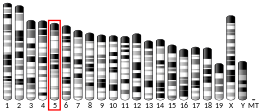
ADGRV1, also known as G protein-coupled receptor 98 (GPR98) or Very Large G-protein coupled receptor 1 (VLGR1), is a protein that in humans is encoded by the GPR98 gene. Several alternatively spliced transcripts have been described.

Cadherin EGF LAG seven-pass G-type receptor 3 is a protein that in humans is encoded by the CELSR3 gene.

Latrophilin 1 is a protein that in humans is encoded by the ADGRL1 gene. It is a member of the adhesion-GPCR family of receptors. Family members are characterized by an extended extracellular region with a variable number of protein domains coupled to a TM7 domain via a domain known as the GPCR-Autoproteolysis INducing (GAIN) domain.

Probable G-protein coupled receptor 124 is a protein that in humans is encoded by the GPR124 gene. It is a member of the adhesion-GPCR family of receptors. Family members are characterized by an extended extracellular region with a variable number of protein domains coupled to a TM7 domain via a domain known as the GPCR-Autoproteolysis INducing (GAIN) domain.

Probable G-protein coupled receptor 78 is a protein that in humans is encoded by the GPR78 gene.

Probable G-protein coupled receptor 135 is a protein that in humans is encoded by the GPR135 gene.

Probable G-protein coupled receptor 123 is a protein that in humans is encoded by the GPR123 gene. It is a member of the adhesion-GPCR family of receptors. Family members are normally characterized by an extended extracellular region with a variable number of protein domains coupled to a TM7 domain via a domain known as the GPCR-Autoproteolysis INducing (GAIN) domain.

GPR113 is a gene that encodes the Probable G-protein coupled receptor 113 protein.

Probable G-protein coupled receptor 115 is a protein that in humans is encoded by the GPR115 gene.

Probable G-protein coupled receptor 111 is a protein that in humans is encoded by the GPR111 gene.

Probable G-protein coupled receptor 110 is a protein that in humans is encoded by the GPR110 gene. This gene encodes a member of the adhesion-GPCR receptor family. Family members are characterized by an extended extracellular region with a variable number of N-terminal protein modules coupled to a TM7 region via a domain known as the GPCR-Autoproteolysis INducing (GAIN) domain.

Probable G-protein coupled receptor 133 is a protein that in humans is encoded by the GPR133 gene.

Probable G-protein coupled receptor 144 is a protein that in humans is encoded by the GPR144 gene. This gene encodes a member of the adhesion-GPCR family of receptors. Family members are characterised by an extended extracellular region with a variable number of protein domains coupled to a TM7 domain via a domain known as the GPCR-Autoproteolysis INducing (GAIN) domain.

EGF, latrophilin and seven transmembrane domain-containing protein 1 is a latrophilin-like orphan receptor of the adhesion G protein-coupled receptor family. In humans this protein is encoded by the ELTD1 gene. ELTD1 appears to have a role in angiogenesis, both physiological and pathological in cancer.

Latrophilin 2 is a protein that in humans is encoded by the ADGRL2 gene.

Leucine-rich repeat-containing G-protein coupled receptor 6 is a protein that in humans is encoded by the LGR6 gene. Along with the other G-protein coupled receptors LGR4 and LGR5, LGR6 is a Wnt signaling pathway mediator. LGR6 also acts as an epithelial stem cell marker in squamous cell carcinoma in mice in vivo.

Cell adhesion molecule 3 is a protein that in humans is encoded by the CADM3 gene.

Protein GPR89 is a protein that in humans is encoded by the GPR89B gene.

Endothelial cell-selective adhesion molecule is a protein that in humans is encoded by the ESAM gene.

Leucine-rich repeat transmembrane protein FLRT3 is a protein that in humans is encoded by the FLRT3 gene.
















